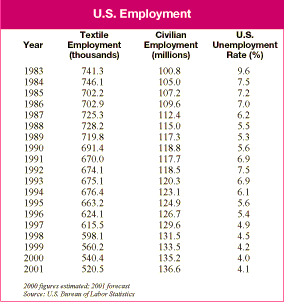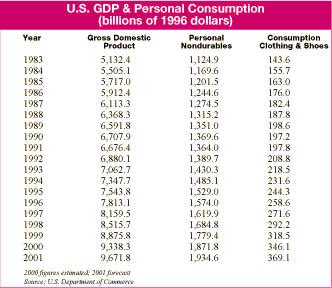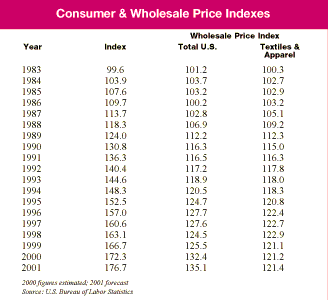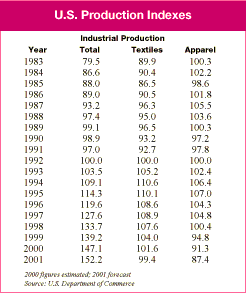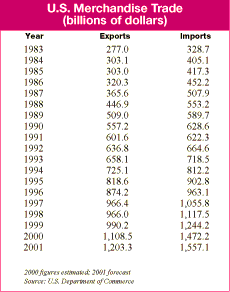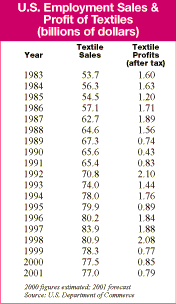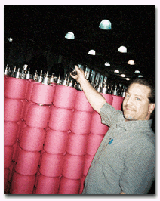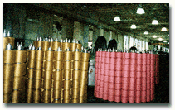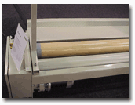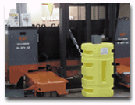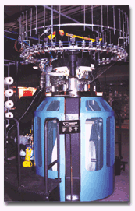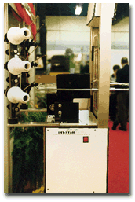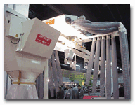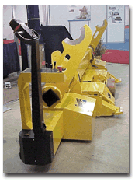Fabric FormationBy David Gross, Consulting Editor Novelty Textile Bases Success On Different Approach To MarketQuick response to customer needs key to small knitting operation. Novelty Textile Mills LLC, Wauregan, Conn., is a different kind of company, and Allan R. Taylor, its owner and president, who purchased the operation in February 2000, takes a different kind of approach to the market.The company is a moderate-sized warpknit operation selling mostly to the apparel trade with sales of this year less than $10 million. Novelty’s edge, according to Taylor, is that it is not a commodity house.”Most of our development work is in apparel and in unique fabric. If we want to maintain our ‘unique’ niche in the market we have to continue to provide products that others can’t make easily or copy easily,” Taylor says.Using that philosophy, Taylor reports, the company’s sales in the less than two years he has owned it have doubled.Among the apparel markets Novelty Textile caters to are misses and juniors. “But what we sell on the California market requires a little bit brighter fabric than what we sell on the New York market.” Most of the fabric goes into women’s tops and jackets with some into cut-and-sew sweaters, according to Taylor. “We also make the trims that go with our products.”The company also produces technical textiles, to which Taylor also takes a different approach than larger companies. “My approach is to develop one technical product at a time. I can’t afford to set up a technical division and hire the people and take on the overhead and then wait two to three years to see whether the division pans out.””To me it’s much smarter to work on one product and become knowledgeable on that and work with one potential buyer to develop it. Once you’ve developed a product in the technical field for a customer, you don’t have to worry about it every season. You don’t have spring and fall and holiday. You often don’t have to remake that product for two, three, four, five or six years.”

Novelty also makes meshes, accessories and throws. Taylor says, “I would probably be receptive to almost anything else somebody else has an idea about. We don’t say no to something until we take a look at it. We’re in business to make money, and to do it where it’s conducive to the operation we have set up. If somebody has a product or an idea, and it’s conducive to our equipment, then we’re interested. We’re a specialty house. We’re not a commodity house where we’re locked into a certain type of thing. We’ll do almost anything.”

For someone working in the knitting industry and heading a knitting operation, Taylor is the first to point out that he is not a technologist. “My strengths are in organization, finance, economics and personnel,” he says.”I’m an accountant by education from Pace.”He joined Novelty in 1980 to fill a temporary management assignment, after working 11 years for McGraw-Hill and heading several departments doing cost analysis, and then about two years at Summy Bircher, the company that owns the song “Happy Birthday” and the North American rights to the Suzuki method of violin and cello, moving that company from Chicago to the New York market.
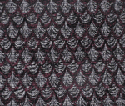
Taylor purchased Novelty Textile from Arthur Feinberg, who, after serving in World War II, had taken over the original company from his father, eventually moving it from Manhattan to Connecticut. Officially, Novelty was established in 1952. Feinberg continues to be “an adviser, assistant and councilor to our success. He’s a great technician and has been important in the development of new products,” Taylor says.
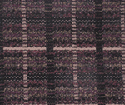
In the 1970s, Novelty went into equal partnership with Thomas HodgsonandSons of Suncook, N.H., giving the company a guaranteed source of yarn. Today, Taylor notes, Novelty is still buying almost all of its facing yarns from Thomas HodgsonandSons, now a part of Kennebunk Weavers, which is a subsidiary of Perfect Fit. Novelty still has a strong relationship with Hodgson. Taylor says,”They still work with us, and the’ve respected the yarns that we’ve developed and protect us by not selling those yarns elsewhere. That’s important when you’re in a venture business such as mine.”

Among the factors that help to maintain Novelty’s uniqueness, Taylor says, are its equipment, the yarns used, the adeptness and cooperation of its employees and the types of fabric knit. “We have equipment that no one else has and we have the North American rights on some of that equipment so some of the appearance and presentation of our goods cannot be duplicated right now.””Some of those fabrics,” Taylor notes, “include so many different yarns that it’s almost impossible for somebody to copy it.”
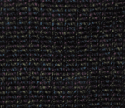
Some styles, for example, use about 38 yarns. “How can we do this We keep a tremendous amount of yarn in inventory at all times of every conceivable color. That gives us the ability, first, to make such fabrics, but it also gives us a tremendous ability to make samples for customers. And we’ll often turn samples for customers in 24 to 48 hours. Being a specialty house we have to be able to make samples and we have to be able to do it quickly.” Taylor notes that Novelty also does its own twisting. “We’ll twist two or three yarns together and make up a unique yarn that no one else has and can’t get. So we’re always looking for something to maintain our uniqueness that can’t be taken away from us. We also tend to work with heavy yarns. We don’t want to go into the fine yarn business. The finest yarn we’ll go to usually is 1,500 yards to the pound. We’ll go to 2,300 once in a while, but most of our yarns are in the 1,000-1,500 range. It gives that heavier but light and lofty look, and it’s unique to us. And we’re known for that.” Novelty’s facility covers 100,000 square feet and is equipped with more than 150 Raschel warp knitting machines. These include an extensive battery of mechanically operated Cidega units. “In addition,” Taylor says, “we bought and developed new electronic machines that provide enhancements to the old Cidega machines. We have the rights on those machines right now. They give us the looks of the Cidega equipment, but some enhancements and improvements and some capabilities we didn’t have with the Cidegas.”I also have the large [Karl] Mayer machines, but I don’t look for any volume production from those. Those machines are not where Novelty’s successes can be realized.” Mayer warp knitting machines are used in many plants in the U.S., Taylor says, noting “What I make on those [machines], most any one can make also. I don’t want to be in a business where I have to compete against somebody else who can make the smae thing. My success is making a unique product that’s not easily duplicated by someone else.”So, Taylor says, the company has modified its Mayer and Kidde Raschel units, both of which were originally designed to produce lace fabrics, to take very heavy yarns. “We’ve modified them to take bulky yarns and we try to run things on them that other people would have difficultry running on that equipment.”Another reason for Novelty Textile’s recent success, Taylor notes, is its development of business with Caribbean Basin countries. “From February on I’ve been shipping containers every week and a half to CBI. This year it’s going to be tremendously advantageous to me. Commitments have been heavy, and up from last year. I already know that the commitments are going to be bigger for next year.”
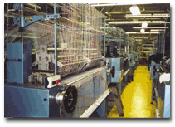
But, he notes, CBI has a major effect on schedules since those countries need 60 days for their flow-through. That means everything has to be shipped out by May 1, which, Taylor notes, was normally the middle of the heaviest production period for U.S.-based knitters.”If you’re in CBI and producing for those people, you’ve got to work for November-December and it could be heavy work. November, December, January, February, March, those are big prime months now. In the past those were months when you were hurting. What that also means is that you have to have your lines early. Whereas, if you had your fall lines for the following year and you had it ready by September or October, that’s great, you were early. Now, you’ve got to have that ready long before October. You should have your fall lines for the following year ready no later than August, and in some cases people want to see them in June or July.” Taylor says, ” The question is, ‘How long will manufacturers continue to buy my product made in America and not substitute it for a cheaper fabric. It can’t look like mine; they can’t do that, but it can look somewhat like it. Will they leave me behind and suddenly go to warp knitted fabrics from Korea or Taiwan or Indonesia (Indonesia is now more of a threat than China)” Taylor points out that fabrics from those markets often can be shipped to Guatemala, for example, and duties paid on them and still be cheaper than what comes out of U.S.-based mills.”Our fabric used to have a 3-year life. With the changes in the economy and the worldwide nature of the economy, if I can have two years protection, I should come out ahead. We recognize that creativity and design becomes even more important and we’ve taken steps to prepare and insure for that. We have the people on board to provide that ability.”Looking to the future, Taylor says,” When I bought this business a year and a half ago, a lot of people said, ‘you’ve got to be out of your mind. In the texitle industry buying a business, what are you doing It’s crazy.’ Well, I knew Novelty’s business because I helped run it for 20 years. But I also believed there was a future in certain aspects as long as you make unique products. I also knew when I bought the business that the year 2005 was going to be critical.
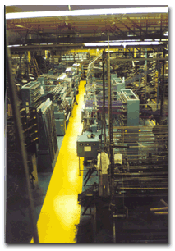
“So I knew I had to create some revenue flow that would not be jeopardized by 2005. Since I was picking as my instrument a company that was not a commodity house, but was a specialty house, and unique, I recognized that the economies of countries like China, Indonesia and Bangladesh are not going to go after my product because my market is too small. If I grow too large in one particular product, I become much more vulnerable to somebody knocking me off and trying to take away a piece of my business. It was part of the plan that I put together.”I projected that by 2005 we’d be very lucky if the life of a product was 18 months to two years. That means that my design and developmental cost have to at least double, because I’ve got to come out with new ideas, new thoughts, new presentations at twice the volume I did before. We’re setting greater strength in the development stage.” To prepare for life after the quota system is phased out at the beginning of 2005, Taylor has also started new businesses. “At some stage I’m going to have to have an avenue to get to the consumer,” Taylor notes. “I’m prepared to see where the future is. And if it requires me to be in some type of joint venture with people to provide my customers with a product, then I’ll do that. So, I have taken the steps to insure that I will be able to offer them that step or something similar to that step to insure that my fabric is still purchased.”Among his ideas are using components from all the companies going out of business that are left over. That incudes yarns and other components they might have used in manufacturing their product. Taylor says he has found a way to take some of those components and turn them into profit in some other way.”It gives me another profit center and that’s what I need,” he says. ” In my business, I don’t limit myself to one narrow little area. I’ll work on anything where I can efficiently make a profit. You name it, I’m doing it if it’s efficient for my operation. And it seems to be working right now. As long as we work at it hard.”October 2001

